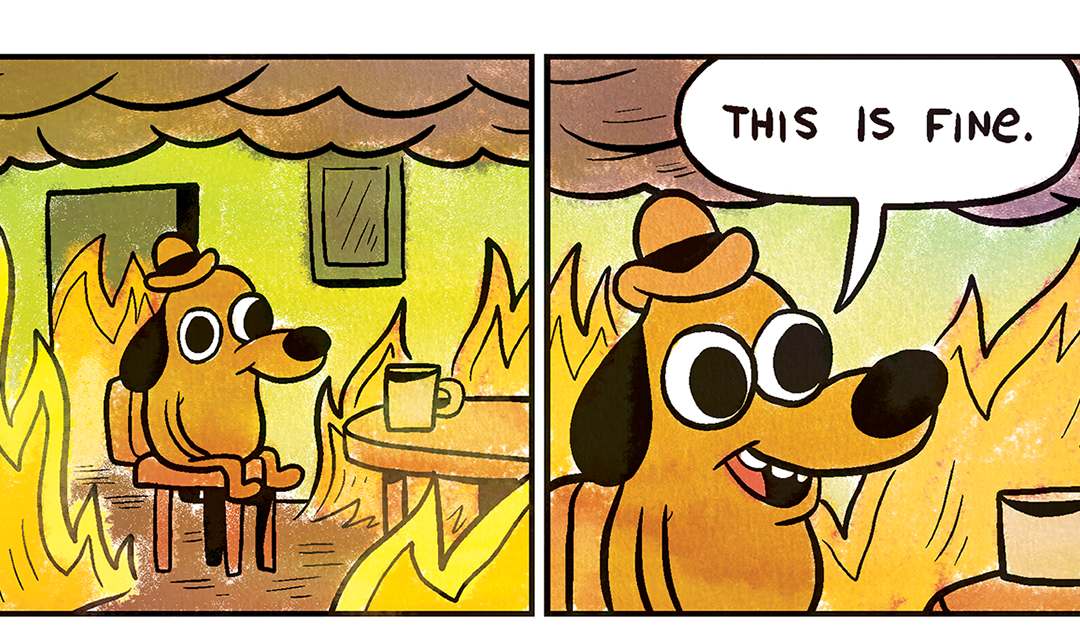
by Robyn Bolton | Apr 9, 2025 | Innovation, Leadership, Tips, Tricks, & Tools
“A Few Good Men” is one of my favorite movies. As much as I love Jack Nicholson’s classic line, “You can’t handle the truth!” lately, I’ve been thinking more about a line delivered by Lt. Daniel Kaffee, played by Tom Cruise – “And the hits just keep on comin’.”
But, just like Lt. Kaffee had to make peace with Lt. Cdr JoAnne Galloway joining his Cuba trip, we must make peace with uncertainty and find the guts to move forward.
This is much easier said than done, but these three steps make it possible. Even profitable.
Where We Begin
Imagine you’re the CEO of Midwest Precision Components (MPW), a $75 million manufacturer of specialized valves and fittings. Forty percent of your components come from suppliers now subject to new tariffs, which, if they stay in effect, threaten an increase of 15% in material costs. This increase would devastate your margins and could require you to reduce staff.
Your competitors are scrambling to replace foreign suppliers with domestic ones. But you know that such rapid changes are also risky since higher domestic prices eat into your margins (though hopefully less than 15%), and insufficient time to quality test new parts could lead to product issues and lost customers. And all this activity assumes that the tariffs stay in place and aren’t suddenly paused or withdrawn.
3 Steps Forward
Entering the boardroom, you notice that the CFO looks more nervous than usual, and your head of Supply Chain is fighting a losing battle with a giant stack of catalogs. Taking a deep breath, you resolve to be creative, not reactive (same letters, different outcomes), and get to work.
Step 1: Start with the goal and work backward. The goal isn’t changing suppliers to reduce tariff impact. It’s maintaining profit margins without reducing headcount or product quality. With your CFO, you whiteboard a Reverse Income Statement, a tool that starts with required (not desired) profits to calculate necessary revenues and allowable costs. After running several scenarios, you land on believable assumptions that result in no more than a 4% increase in costs.
Step 2: Identify and prioritize assumptions. With the financial assumptions identified, you ask the leadership team to list everything that must be true to deliver the financial assumptions, their confidence that each of their assumptions is true, and the impact on the business and its bottom line if the assumption is wrong.
Knowing that your head of Sales is an unrelenting optimist and your Supply Chain head is mired in a world of doom and gloom, you set a standard scale: High confidence means betting your annual salary, medium is a team dinner at a Michelin-starred restaurant, and low is a cup of coffee. High impact puts the company out of business, medium requires major shifts, and low means extra work but nothing crazy.
Step 3: Attack the deal killers. Going around the room, each person lists their “Deal Killers,” the Low Confidence – High Impact assumptions that pose the highest risk to the business. After some discussion to determine the primary assumptions at the beginning of causal chains, you select two for immediate action: (1) Alternative domestic suppliers can be found for the two highest-cost components, and (2) Current manufacturing processes can be quickly adapted to accommodate parts from new suppliers.
A Plan. A Timeline. A Sense of Calm.
With this new narrowed focus, your team sets a shared goal of resolving these two assumptions within 30 days. Together, they set clear weekly deliverables and reallocate time and people to help meet deadlines.
A sense of calm settles on the team. Not because they have everything figured out, but because they know exactly what the most important things to be done are, that those things are doable, and they are working together to do them.
How could you use these three steps to help you move forward through uncertainty?

by Robyn Bolton | Mar 19, 2025 | Innovation, Leadership, Tips, Tricks, & Tools
Risk management is critical in uncertain times. But traditional approaches don’t always help when volatility, ambiguity, and complexity are off the charts.
What many leaders overlook in their rush to safety is that many of the most effective tools for managing risk come from an unexpected place: innovation.
The Counterintuitive Truth About Risk Management
Risk Management’s purpose isn’t to eliminate risks. It’s to proactively identify, plan for, and minimize risk. Innovation is inherently uncertain, so its tools are purpose-built to proactively identify, plan for, and minimize risk. They also help you gain clarity and act decisively—even in the most chaotic environments.
Here are just three of the many tools that successful companies use to find clarity in chaos.
Find the Root Cause
When performance dips, most leaders jump to fix symptoms. True risk management means digging deeper. Root cause analysis—particularly the “5 Whys”—helps uncover what’s really going on.
Toyota made this famous. In one case, a machine stopped working. The first “why” pointed to a blown fuse. The fifth “why” revealed a lack of maintenance systems. Solving that root issue prevented future breakdowns.
IBM reportedly used a similar approach to reduce customer churn. Pricing and product quality weren’t the problem—friction during onboarding was. After redesigning that experience, retention rose by 20%.
Focus on What You Can Actually Control
Trying to manage everything is a recipe for burnout. Better risk management starts by separating what you can control, what you can influence, and what you can only monitor. Then, allocate resources accordingly.
After 9/11, most airlines focused on uncontrollable external threats. Southwest Airlines doubled down on what they could control: operational efficiency, customer loyalty, and employee morale. They avoided layoffs and emerged stronger.
Unilever used a similar approach during the global supply chain crisis. Instead of obsessing over global shipping delays, they diversified suppliers and localized sourcing—reducing risk without driving up costs.
Attack Your “Deal Killer” Assumptions
Every plan is based on assumptions. Great risk management means identifying the ones that could sink your strategy—and testing them before you invest too much time or money.
Dropbox did this early on. Instead of building a full product, they made a simple video to test whether people wanted file-syncing software. They validated demand, secured funding, and avoided wasted development.
GE applied this logic in its FastWorks program. One product team tested their idea with a quick prototype. Customer feedback revealed a completely different need—saving the company millions in misdirected R&D.
Risk Management Needs Innovation’s Tools for a VUCA World
The best risk managers don’t just react to uncertainty—they prepare for it. These tools aren’t just for innovation—they’re practical, proven ways to reduce risk, respond faster, and make smarter decisions when the future feels murky.
What tools or strategies have helped you manage risk during uncertain times? I’d love to hear in the comments.

by Robyn Bolton | Feb 18, 2025 | Innovation, Leadership, Metrics, Tips, Tricks, & Tools
Innovation is undergoing a metamorphosis, and while it may seem like the current goo-stage is the hard part (it’s certainly not easy!), our greatest challenge is still ahead. Because while we may emerge as beautiful butterflies, we still need to get buy-in for change from a colony of skeptical caterpillars who’ve grown weary of transformation talk.
The Old Playbook Is Dead, Too
Picture this: A butterfly lands, armed with PowerPoint slides about “The Future of Leaf-Eating” and projections showing “10x Nectar Collection Potential.” The caterpillars stare blankly, having seen this show before.
The old approach – big presentations, executive sponsorship, and promises of massive returns within 24 months – isn’t just ineffective. It’s harmful. Each failed transformation makes the next one harder, turning your caterpillars more cynical and more determined to cling to their leaves.
The Secret Most Change Experts Miss
Butterflies don’t convince caterpillars to transform by showing off their wings. They create conditions where transformation feels possible, necessary, and safe. Your job isn’t to sell the end state – it’s to help others see their own potential for change.
Here’s how:
Start With the Hungriest Caterpillars
Find those who feel the limitations of their current state most acutely. They’re not satisfied with their current leaf, and they’re curious about what lies beyond. These early adopters become your first chrysalis cohort.
Make it About Their Problems, Not Your Vision
Instead of talking about transformation, focus on specific pain points. “Wouldn’t it be easier to reach that juicy leaf if you could fly?” is more compelling than “Flying represents a paradigm shift in leaf acquisition strategy.”
Build a Network of Proof
Every successful mini-transformation creates evidence that change is possible. When one caterpillar successfully navigates their chrysalis phase, others pay attention. Let your transformed allies tell their stories.
Set Realistic Expectations
Metamorphosis takes time and isn’t always pretty. Be honest about the goo phase – that messy middle where things fall apart before they come together. This builds trust and prepares people for the real journey, not the sanitized version.
Where to Start
- Identify your first chrysalis cohort – the people already feeling the limits of their current state
- Focus on solving immediate problems that showcase the benefits of change
- Document and share small victories, letting others tell their transformation stories
- Create realistic timelines that acknowledge both quick wins and longer-term metamorphosis
What’s your experience? Have you successfully guided a transformation without relying on buzzwords and fancy presentations? Drop your stories in the comments.
After all, we’re all just caterpillars and butterflies helping each other find our wings.

by Robyn Bolton | Feb 3, 2025 | Innovation, Tips, Tricks, & Tools
If innovation (the term) is dead and we will continue to engage in innovation (the activity), how do we talk about creating meaningful change without falling back on meaningless buzzwords? The answer isn’t finding a single replacement word – it’s building a new innovation language that actually describes what we’re trying to achieve. Think of it as upgrading from a crayon to a full set of oil paints – suddenly you can create much more nuanced pictures of progress.
The Problem with One-Size-Fits-All
We’ve spent decades trying to cram every type of progress, change, and improvement into the word “innovation.” It’s like trying to describe all forms of movement with just the word “moving.” Sure, you’re moving but without the specificity of words like walking, running, jumping, bounding, and dancing, you don’t know what or how you’re moving or why.
That’s why using “innovation” to describe everything different from today doesn’t work.
Use More Precise Language for What and How
Before we throw everything out, let’s keep what actually works: Innovation means “something new that creates value.” That last bit is crucial – it’s what separates meaningful change from just doing new stuff for novelty’s sake. (Looking at you, QR code on toothpaste tutorials.)
But, just like “dancing” is a specific form of movement, we need more precise language to describe what the new value-creating thing is that we’re doing:
- Core IMPROVEMENTS: Making existing things better. It’s the unglamorous but essential work of continuous refinement. Think better batteries, faster processors, smoother processes.
- Adjacent EXPANSIONS: Venturing into new territory – new customers, new offerings, new revenue models, OR new processes. It’s like a restaurant adding delivery service: same food, new way of reaching customers.
- Radical REINVENTION: Going all in, changing multiple dimensions at once. Think Netflix killing its own DVD business to stream content they now produce themselves. (And yes, that sound you hear is Blockbuster crying in the corner.)
Adopt More Sophisticated Words to Describe Why
Innovation collapsed because innovation became an end in and of itself. Companies invested in it to get good PR, check a shareholder box, or entertain employees with events.
We forgot that innovation is a means to an end and, as a result, got lazy about specifying what the expected end is. We need to get back to setting these expectations with words that are both clear and inspiring
- Growth means ongoing evolution
- Transformation means fundamental system change (not just putting QR codes on things)
- Invention means creating something new without regard to its immediate usefulness
- Problem Solving means finding, creating, and implementing practical solutions
- Value Creation means demonstrating measurable and meaningful impact
Why This Matters
This isn’t just semantic nitpicking. Using more precise language sets better expectations, helps people choose the most appropriate tools, and enables you to measure success accurately. It’s the difference between saying “I want to move more during the day” and “I want to build enough endurance to run a 5K by June.”
What’s Next?
As we emerge from innovation’s chrysalis, maybe what we’re becoming isn’t simpler – it’s more sophisticated. And maybe that’s exactly what we need to move forward.
Drop a comment: What words do you use to describe different types of change and innovation in your organization? How do you differentiate between what you’re doing and why you’re doing it?

by Robyn Bolton | Nov 19, 2024 | Innovation, Leadership, Tips, Tricks, & Tools
“We identified four opportunities for market expansion, all adjacent to our current business, and entry into any one of them is almost guaranteed to materially grow our business. But no one is doing anything.”
I wanted to be surprised. Instead, I sighed and asked the question I knew he couldn’t answer.
“What are your colleagues afraid of?”
The Four Horsemen of the Apocalypse
Most of the time, when opportunities are clear, but action is absent, it’s because one of the first three horsemen of the innovation apocalypse appeared:
- Short-termism: “The CFO is worried we may miss the quarter, so we’re starting to make cuts.”
- Size: “We have a new President coming in who wants to put his stamp on things, so he’s cutting anything that won’t double out business in three years.”
- Scarcity: “We’re implementing a new process, and this would just be one thing too many for people to handle.”
The business my client described has doubled in the past five years. After fifty years of steady, reliable, and predictable revenue, its top line suddenly became the mythical “hockey stick of growth.” The technological driver of this change is more likely to be the “new normal” than a fad, so the business is expected to double again in the next five years.
Leadership isn’t worried about delivering the next quarter, year, or five years. They know that they have the resources they need and can access more when the time is right. They’re confident that the opportunities identified are feasible and meaningful.
Yet, they will not act.
I’m not afraid. I’m biased!
Behavioral economists, psychologists, and sociologists explain situations like the above by pointing out our “cognitive biases”—the “irrational errors that are programmed into our brains.” For example, the first three horsemen could be known as Present Bias, the hard-easy effect, and Loss Aversion.
As of 2024, over 150 cognitive biases have been identified.
While it’s comforting to blame programming bugs beyond our awareness and control for our “irrational errors,” this approach lets us off the hook a bit too easily.
I’m not biased. I’m afraid!
Fear is at the root of most, if not all, of these biases because emotions, not programming bugs in our brains, drive our decisions.
The study of how our emotions impact decision-making didn’t take off until the early 2000s. It really accelerated in 2015 when professors from Harvard, UC Riverside, Claremont McKenna College, and Carnegie Mellon published a meta-study on the topic and declared:
The research reveals that emotions constitute potent, pervasive, predictable, sometimes harmful and sometimes beneficial drivers of decision making. Across different domains, important regularities appear in the mechanisms through which emotions influence judgments and choices.
Bottom line – we decide with our hearts and justify with our heads.
Our hearts are afraid that we’ll lose the respect of our peers and loved ones, the reputations we’ve worked decades to build, the physical goods and intangible experiences that project our societal status, or the financial safety of a regular paycheck.
And, as my brilliant and kind sister told me, “These feelings we feel, these feelings are real.”
I’m afraid and biased and brave!
Next time you see someone (maybe you?) do something “irrational,” get curious and ask:
- What cognitive bias are they falling prey to?
- What is the fear that’s driving that bias?
- How can you help them to be brave, live with the fear, and move forward?
I’m curious…when was the last time you were afraid, biased, and brave?




